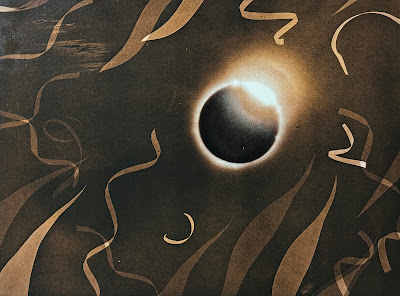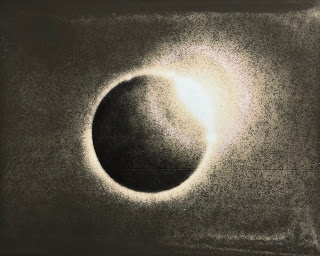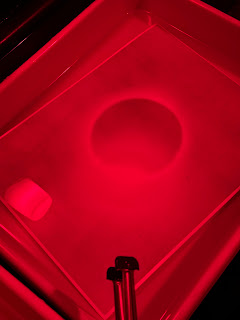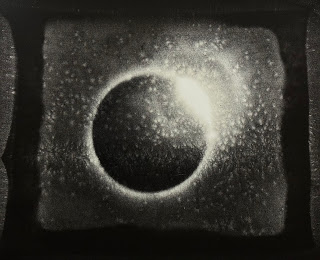One of the lithographic gelatin silver prints
While traveling to Missouri for the total solar eclipse on April 8th 2024, the main goals were to see this marvelous sight and to attempt to capture totality in both daguerreotype and wet plate collodion techniques. Actually, initially I was just thinking of doing only daguerreotypes, but that technique can be very fickle, especially so if performed out in a completely uncontrolled natural setting. Thus I decided to bring a wet collodion setup for backup, in case no daguerreotypes worked out, as with collodion I was pretty certain that the results would be worth the hassle. Here are a few images from that memorable day, spent amid the trees doing what I truly love.
Zone VI 8x10 awaiting totality
Camera and dark boxes, almost time
Glass waiting for collodion
The glass plate was coated with collodion right as totality set in, and I’ll admit it was far from my best pour, as I’ve never felt the same peculiar way before. After plunging the plate into the silver bath for sensitization, I exposed the prepped daguerreotype plates, ran back to the dark box and, without even closing its front, extracted the plate and placed it in the holder, assuming that there really isn’t going to be a lot of UV light to affect the image. Perhaps this actually acted as pre-flashing and helped my exposure. Somehow, with me pausing on my way back to the camera to stare upward with joyful awe for a few seconds, the timing worked out rather miraculously, and in the end of my predetermined 4 second exposure, the sun made its reappearance with the diamond ring moment, at which point I promptly replaced the lens cap. After developing the collodion negative, it was given one round of iodine redevelopment treatment, at which point I determined that it was of sufficient density for what I envisioned doing with it.

Collodion negative in rinse
The idea that I should make lith prints came to me spontaneously and almost immediately after the moment that I covered the lens, and realized that I may have a shot at having been the first person ever to capture the diamond ring moment in wet collodion. As I was rushing back to the dark box to develop the negative, I realized that all the variables beyond my control were falling in places on their own accord, with my work basically acting as a guide for the final result. It was at this point that the unpredictable nature of lithographic developer when combined with gelatin silver papers popped into my head. Every print made that way is entirely unique, because try all you want, but you’ll never match two of them, simply due to the nature of those types of developers. There are many books written about lith developer, and so I won’t bore you with details of how it works and why it’s so fun.
I’m very glad that, over the past 25 years or so, every time I came across no longer manufactured photo papers, I stashed them away for something meaningful down the road. Last time I printed with lithographic developer was about 15 years ago, but I always had some laying around in case I wanted to use some of my stash of Kodalith film, which is a whole different story in its own right. One of the funnest parts of this type of developer, is that it allows for printing on papers that with conventional developers would be entirely unusable, as paper fogs with age, and its white base starts to slowly gain tonality, going all the way to black. Lith developers don’t hit that base fog, leaving white areas as they should be, while producing some unexpected colors with certain papers and leaving others perfectly neutral grey. Another exciting element to printing with age-old papers is how they deteriorate, and how lith developer acts upon and exaggerates oxidation and other impurities, producing unexpected textures and patterns that vary widely depending on paper type and how each paper was affected by age. Darkroom time is sacred, and I’ve been sequestering myself in those magical spaces since the age of twelve, so here are a few images of this latest printing session.
During enlargement onto 11x14in
Lith developer doing its thing.
11x14 during selective bleaching and toning
From my vintage photo paper repository, I selected choice 8x10in, 11x14in, and 16x20in packs from companies such as Luminos, Gevaert, DuPont, Defender, Cachet, and of course Kodak. Expiration and manufacturing dates spanned almost all through the 20th century, with the oldest having been made in around 1938 (expiration date on box was 1941), and the most recent one from around 1999 (early 2002 expiration printed). Most of the paper was from 1960s and 70s, so it’s been waiting for an image for over half a century. Some of the open packs and boxes I’be been so carefully caring for apparently only had a few sheets left in them, and in one I only found two small cutoffs, but each one yielded something beautiful. Tremendous variability and lack of full control prompted me to let go off my usual yearning for high precision, and I just let each sheet finally express itself.
Now that all of them have been meticulously spotted using our best darkroom friend SpotOne, I will do one more round of culling those prints I deem to be less than perfect, but overall I’ll end up with about 20 8x10s, maybe around 25 11x14s and 17 or so 16x20s. The first edition is now closed and below are a few samples of the prints, which were hastily copied with my phone just after the final wash.
11x14in
11x14in
16x20in
11x14in
8x10in
8x10in
16x20in
These works are priced at $250, $500, and $750 for the three sizes in which this image has been printed. For now they may only be purchased by directly contacting me via email, and I’m glad to say that a few prints have already been acquired by people who know my art personally.
After doing all the varied lith prints, I did want to see what a straight print from this negative would look like, and so made an 8x10in on new Ilford paper with regular developer. Then, to see the entire negative in all its collodion glory, I pulled out some 4.5x5.5in deckle edge double weight AZO paper from 1954. Finally, not to let my Moersch developer go to waste, I reached for the 3.5x5.5in AZO Post Card paper from 1970, and made a limited run of real mailable post cards, which will go out to places yet to be determined. On both of the AZO runs, I again used selective toning with selenium, because otherwise it would be less fun to have all prints look the same. Here are the straight prints, showing exactly what it is that my adventure yielded. The whole thing was really a shot in the dark, but by golly I’m over the moon about it.
8x10in straight gelatin silver enlargement
Contact Print on 1954 AZO Deckle Edge
Contact Print on 1970 AZO Post Card paper
To request a selection of prints available for purchase at the moment, send a message to thephotopalace@gmail.com
Anton


























































